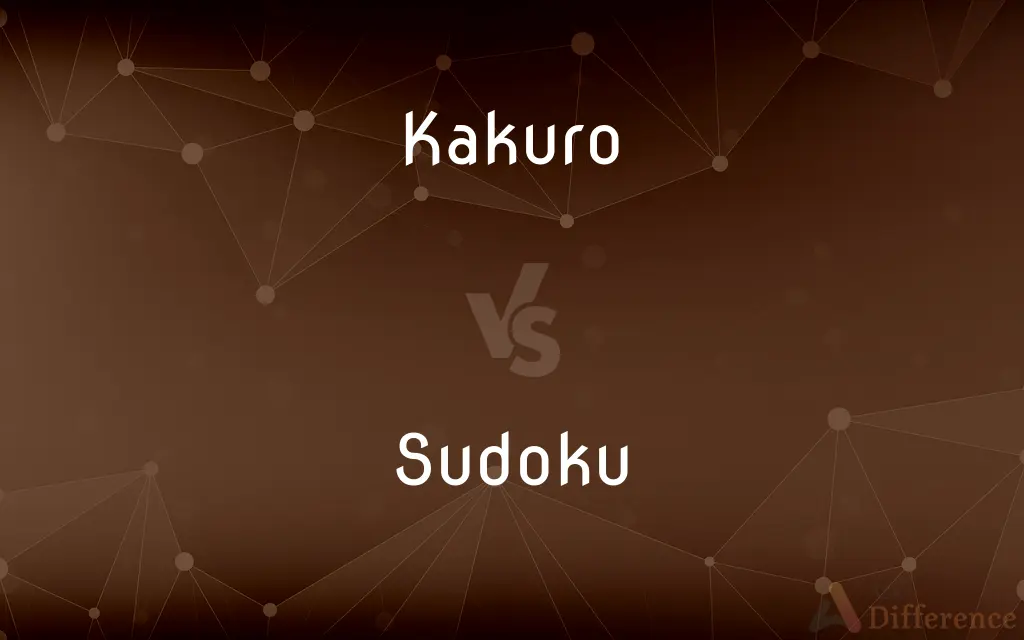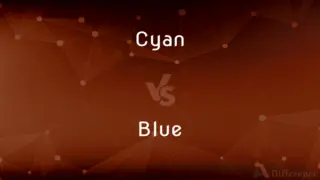Kakuro vs. Sudoku — What's the Difference?
By Tayyaba Rehman & Fiza Rafique — Updated on April 24, 2024
Kakuro is a crossword-like puzzle using numbers for sums, while Sudoku focuses on filling grids with numbers 1-9 without repeating in rows, columns, and regions.

Difference Between Kakuro and Sudoku
Table of Contents
ADVERTISEMENT
Key Differences
Kakuro puzzles, often referred to as "cross-sums," use a crossword-style grid where numbers must add up to given sums along the defined vertical and horizontal lines. In contrast, Sudoku is played on a 9x9 grid divided into nine 3x3 squares, where each number from 1 to 9 must appear once per row, column, and square without repetition.
In Kakuro, the challenge lies in determining which combination of unique digits (from 1 to 9) sum up to the clues provided for each line, with no repeats allowed in any line. On the other hand, Sudoku’s challenge revolves around logical deduction based on existing numbers in the grid to determine the placement of all numbers so they meet the game's conditions.
Kakuro grids are not uniform and can vary greatly in shape and size, with blank cells that do not contain numbers, only adding complexity to the puzzle. Whereas, Sudoku grids are very uniform, always using a 9x9 grid format with predefined numbers that guide the puzzle's completion.
Kakuro puzzles often require a blend of mathematical calculations and logical thinking as players work to meet the exact sums required for each line. Conversely, Sudoku focuses entirely on logical placement and does not involve any arithmetic operations.
While Kakuro might appeal more to those who enjoy numerical calculations along with logical challenges, Sudoku often attracts players who prefer pure pattern recognition and logical reasoning, without the mathematical element.
ADVERTISEMENT
Comparison Chart
Puzzle Type
Crossword-like with numbers
Number placement grid
Main Challenge
Summing numbers to meet clues
Filling grids with no repetition
Grid Layout
Variable shapes and sizes
Uniform 9x9 grid
Skills Emphasized
Arithmetic and logic
Logic and pattern recognition
Typical Player Appeal
Number puzzle enthusiasts
Logical thinkers
Compare with Definitions
Kakuro
A number puzzle based on cross-sums where digits must add to given values.
Completing a Kakuro puzzle requires balancing between possible digit combinations.
Sudoku
Begins with some numbers already placed; these are hints.
The starting numbers in Sudoku help guide the solution process.
Kakuro
No repeated numbers within the same word (line of white cells).
A horizontal line summing to 16 might include the numbers 7, 9, but not two 8s.
Sudoku
Popular worldwide and known for its deep logical challenges.
Sudoku puzzles vary in difficulty, catering to beginners and experts alike.
Kakuro
Focused more on arithmetic than Sudoku.
Kakuro combines elements of crosswords and mathematics.
Sudoku
A logic-based number-placement puzzle.
Solving Sudoku involves figuring out where to place numbers on a grid.
Kakuro
Each "word" has a clue number indicating the sum of the digits within that word.
A clue of 23 across means the sum of the numbers in that line is 23.
Sudoku
Composed of a 9x9 grid divided into nine 3x3 squares.
Each row, column, and square in Sudoku must have numbers 1 to 9 without repeats.
Kakuro
Played on a grid with black and white cells, where white cells are filled with numbers.
In Kakuro, black cells block the continuation of a line.
Sudoku
Does not require arithmetic calculations.
Sudoku relies purely on logic and pattern recognition.
Kakuro
Kakuro or Kakkuro or Kakoro (Japanese: カックロ) is a kind of logic puzzle that is often referred to as a mathematical transliteration of the crossword. Kakuro puzzles are regular features in many math-and-logic puzzle publications across the world.
Sudoku
Sudoku (数独, sūdoku, digit-single) (, , , originally called Number Place) is a logic-based, combinatorial number-placement puzzle. In classic sudoku, the objective is to fill a 9×9 grid with digits so that each column, each row, and each of the nine 3×3 subgrids that compose the grid (also called "boxes", "blocks", or "regions") contains all of the digits from 1 to 9.
Kakuro
(games) A type of number puzzle, similar to a crossword but with numbers. Each "clue" is the sum of the digits to be placed in its group of squares, and no digit can be repeated within a group.
Sudoku
A puzzle in which a grid consisting of several regions is to be filled with numbers so that every row, column, and region contains only one instance of each number. The most common format is a grid of nine rows and columns that are divided into nine smaller regions of three rows and three columns into which the numbers 1 through 9 must be placed.
Sudoku
A type of pencil puzzle played on a square grid, requiring each of the columns, each of the rows, and each of the subregions (called "boxes" or "regions") to contain the lowest whole numbers up to the dimension of the puzzle, usually 1 to 9, once each. The subregions are rectangular or square except in variants.
Common Curiosities
What skills can Sudoku improve?
Sudoku can help improve logical thinking, problem-solving, and pattern recognition skills.
Can Kakuro puzzles be solved without guessing?
Yes, Kakuro puzzles can be solved through logical deduction and arithmetic, without needing to guess.
How does Sudoku ensure a unique solution?
Sudoku grids are designed so that there is only one possible configuration that satisfies all conditions, ensuring a unique solution through logical deduction.
What is the main goal of Kakuro?
The goal of Kakuro is to fill the grid with numbers that sum up to the specified clues without repeating numbers in any line.
How does the complexity of Kakuro grids affect the gameplay?
The complexity of Kakuro grids, with varying shapes and the number of cells, significantly increases the difficulty, requiring more advanced logical and arithmetic skills.
Are there electronic versions of Kakuro?
Yes, Kakuro puzzles are available in electronic form, including online games and apps, offering digital solvers interactive ways to play.
What is the best way to start learning Sudoku?
The best way to start learning Sudoku is to begin with simple puzzles and gradually progress to more difficult ones as understanding of the game improves.
Are there different levels of difficulty in Kakuro puzzles?
Yes, Kakuro puzzles come in various difficulty levels, ranging from simple to very challenging, depending on the layout and size of the grid.
What makes Kakuro unique compared to other number puzzles?
Kakuro is unique in combining elements of crossword puzzles with arithmetic, offering a distinctive challenge focused on sums.
Do both Kakuro and Sudoku require mathematical skills?
Kakuro requires basic arithmetic skills, while Sudoku does not involve math but focuses on logic and placement.
How are Kakuro puzzles structured?
Kakuro puzzles are structured with a mix of black (empty) and white (numbered) cells, with sums indicated for each horizontal and vertical line of white cells.
Is Sudoku suitable for all ages?
Yes, Sudoku is suitable for all ages as it offers varying levels of difficulty and can be enjoyed by both beginners and advanced players.
Are there world championships for Kakuro?
While less common than Sudoku, Kakuro competitions do exist, often as part of larger puzzle tournaments.
What is a common strategy for solving Sudoku?
A common strategy is to identify which numbers are already used in a row, column, or square and determine the missing numbers through elimination.
Can Sudoku be played competitively?
Yes, Sudoku is often played in competitions worldwide, including national and international tournaments.
Share Your Discovery

Previous Comparison
Cyan vs. Blue
Next Comparison
Landmark vs. MilestoneAuthor Spotlight
Written by
Tayyaba RehmanTayyaba Rehman is a distinguished writer, currently serving as a primary contributor to askdifference.com. As a researcher in semantics and etymology, Tayyaba's passion for the complexity of languages and their distinctions has found a perfect home on the platform. Tayyaba delves into the intricacies of language, distinguishing between commonly confused words and phrases, thereby providing clarity for readers worldwide.
Co-written by
Fiza RafiqueFiza Rafique is a skilled content writer at AskDifference.com, where she meticulously refines and enhances written pieces. Drawing from her vast editorial expertise, Fiza ensures clarity, accuracy, and precision in every article. Passionate about language, she continually seeks to elevate the quality of content for readers worldwide.














































